Lexus IS220d 2012 Owner's Manual
Manufacturer: LEXUS, Model Year: 2012, Model line: IS220d, Model: Lexus IS220d 2012Pages: 609, PDF Size: 14.63 MB
Page 431 of 609
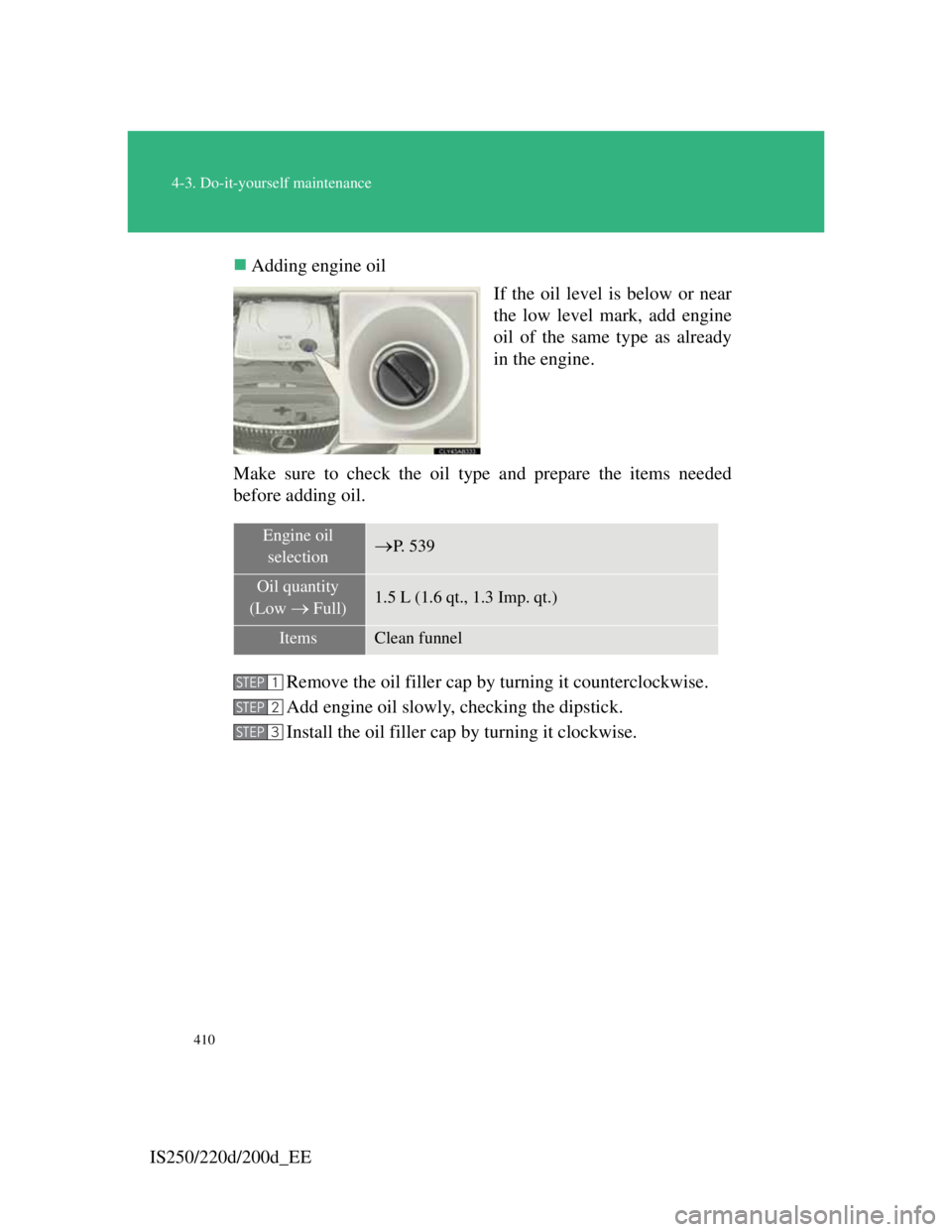
410
4-3. Do-it-yourself maintenance
IS250/220d/200d_EEAdding engine oil
If the oil level is below or near
the low level mark, add engine
oil of the same type as already
in the engine.
Make sure to check the oil type and prepare the items needed
before adding oil.
Remove the oil filler cap by turning it counterclockwise.
Add engine oil slowly, checking the dipstick.
Install the oil filler cap by turning it clockwise.
Engine oil
selectionP. 5 3 9
Oil quantity
(Low
Full)1.5 L (1.6 qt., 1.3 Imp. qt.)
ItemsClean funnel
STEP1
STEP2
STEP3
Page 432 of 609
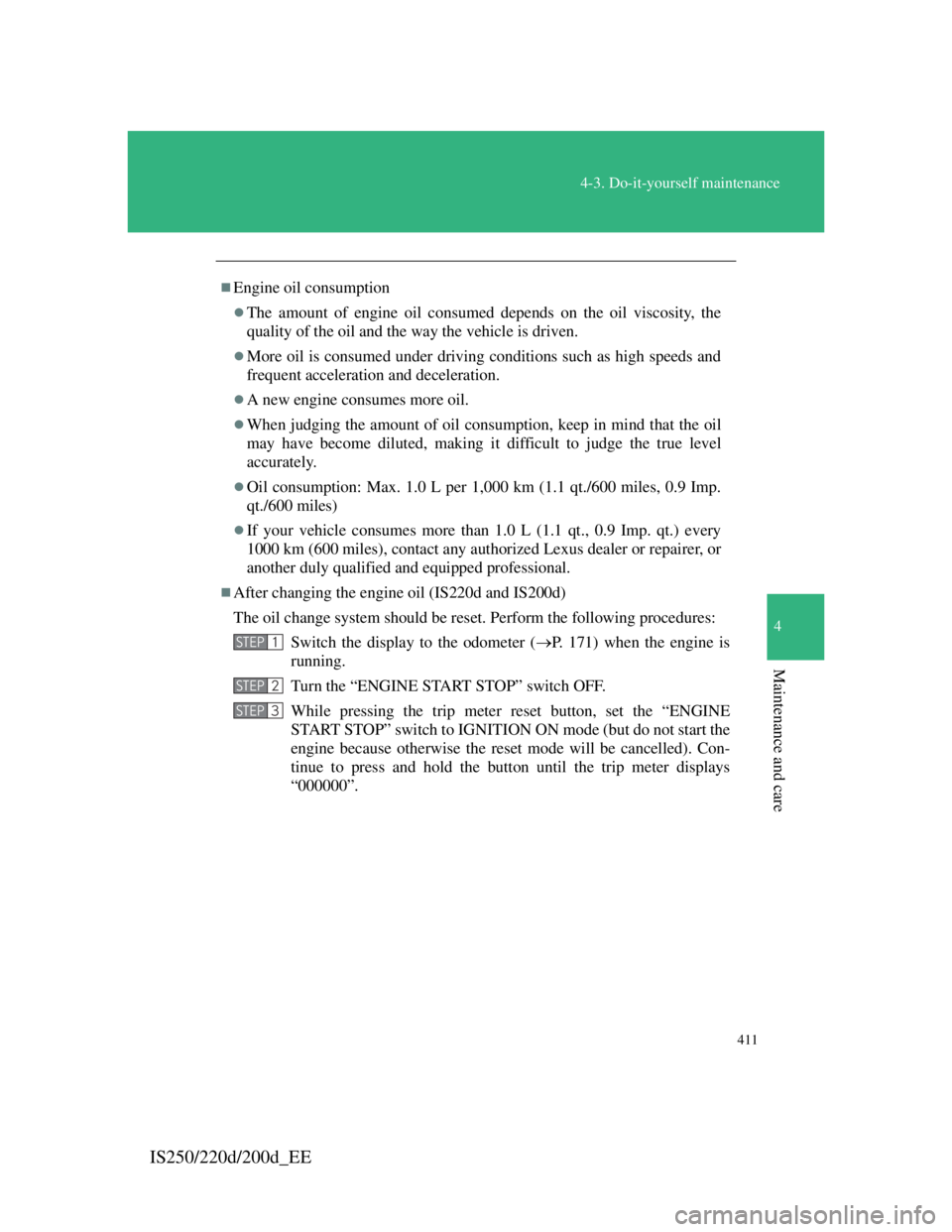
411
4-3. Do-it-yourself maintenance
4
Maintenance and care
IS250/220d/200d_EE
Engine oil consumption
The amount of engine oil consumed depends on the oil viscosity, the
quality of the oil and the way the vehicle is driven.
More oil is consumed under driving conditions such as high speeds and
frequent acceleration and deceleration.
A new engine consumes more oil.
When judging the amount of oil consumption, keep in mind that the oil
may have become diluted, making it difficult to judge the true level
accurately.
Oil consumption: Max. 1.0 L per 1,000 km (1.1 qt./600 miles, 0.9 Imp.
qt./600 miles)
If your vehicle consumes more than 1.0 L (1.1 qt., 0.9 Imp. qt.) every
1000 km (600 miles), contact any authorized Lexus dealer or repairer, or
another duly qualified and equipped professional.
After changing the engine oil (IS220d and IS200d)
The oil change system should be reset. Perform the following procedures:
Switch the display to the odometer (P. 171) when the engine is
running.
Turn the “ENGINE START STOP” switch OFF.
While pressing the trip meter reset button, set the “ENGINE
START STOP” switch to IGNITION ON mode (but do not start the
engine because otherwise the reset mode will be cancelled). Con-
tinue to press and hold the button until the trip meter displays
“000000”.
STEP1
STEP2
STEP3
Page 433 of 609
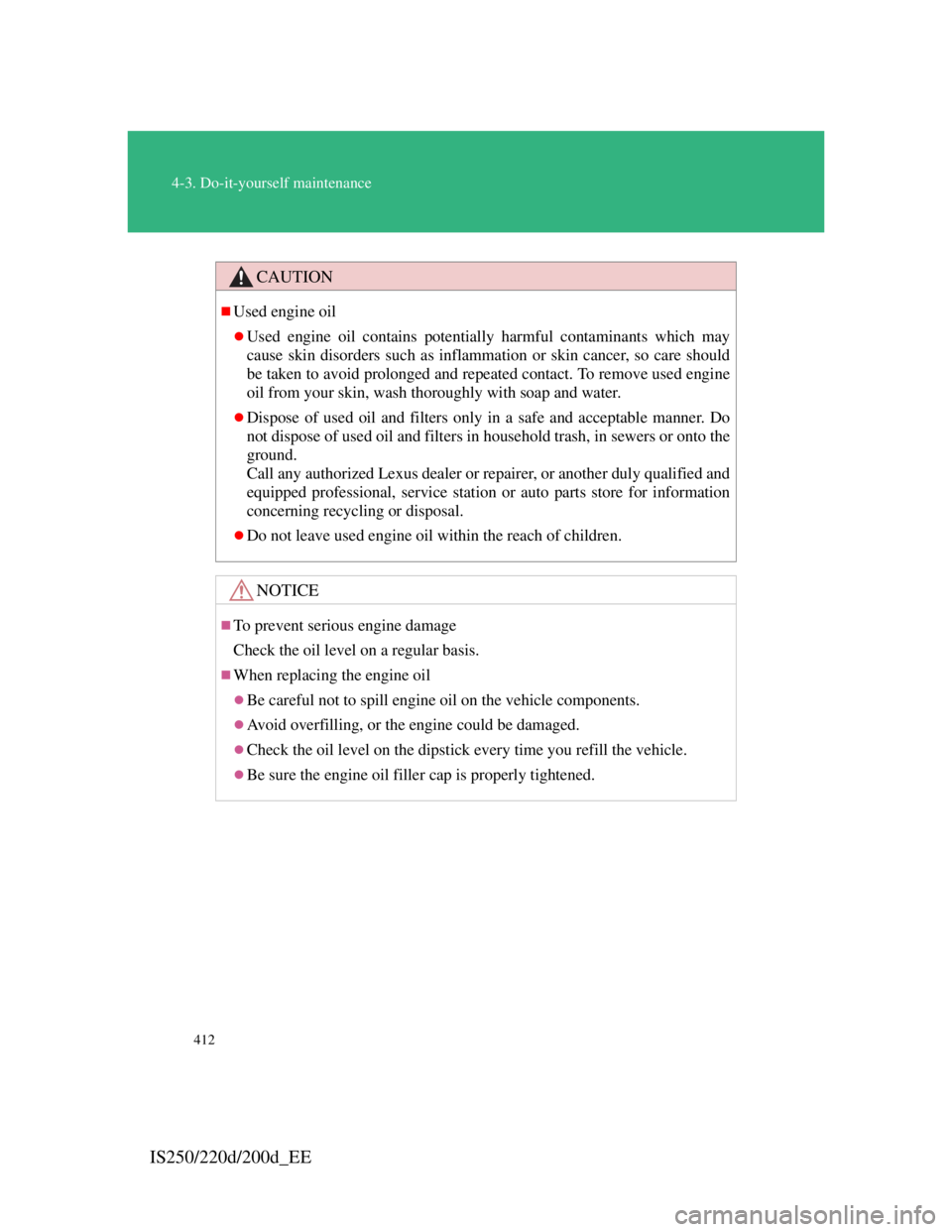
412
4-3. Do-it-yourself maintenance
IS250/220d/200d_EE
CAUTION
Used engine oil
Used engine oil contains potentially harmful contaminants which may
cause skin disorders such as inflammation or skin cancer, so care should
be taken to avoid prolonged and repeated contact. To remove used engine
oil from your skin, wash thoroughly with soap and water.
Dispose of used oil and filters only in a safe and acceptable manner. Do
not dispose of used oil and filters in household trash, in sewers or onto the
ground.
Call any authorized Lexus dealer or repairer, or another duly qualified and
equipped professional, service station or auto parts store for information
concerning recycling or disposal.
Do not leave used engine oil within the reach of children.
NOTICE
To prevent serious engine damage
Check the oil level on a regular basis.
When replacing the engine oil
Be careful not to spill engine oil on the vehicle components.
Avoid overfilling, or the engine could be damaged.
Check the oil level on the dipstick every time you refill the vehicle.
Be sure the engine oil filler cap is properly tightened.
Page 434 of 609
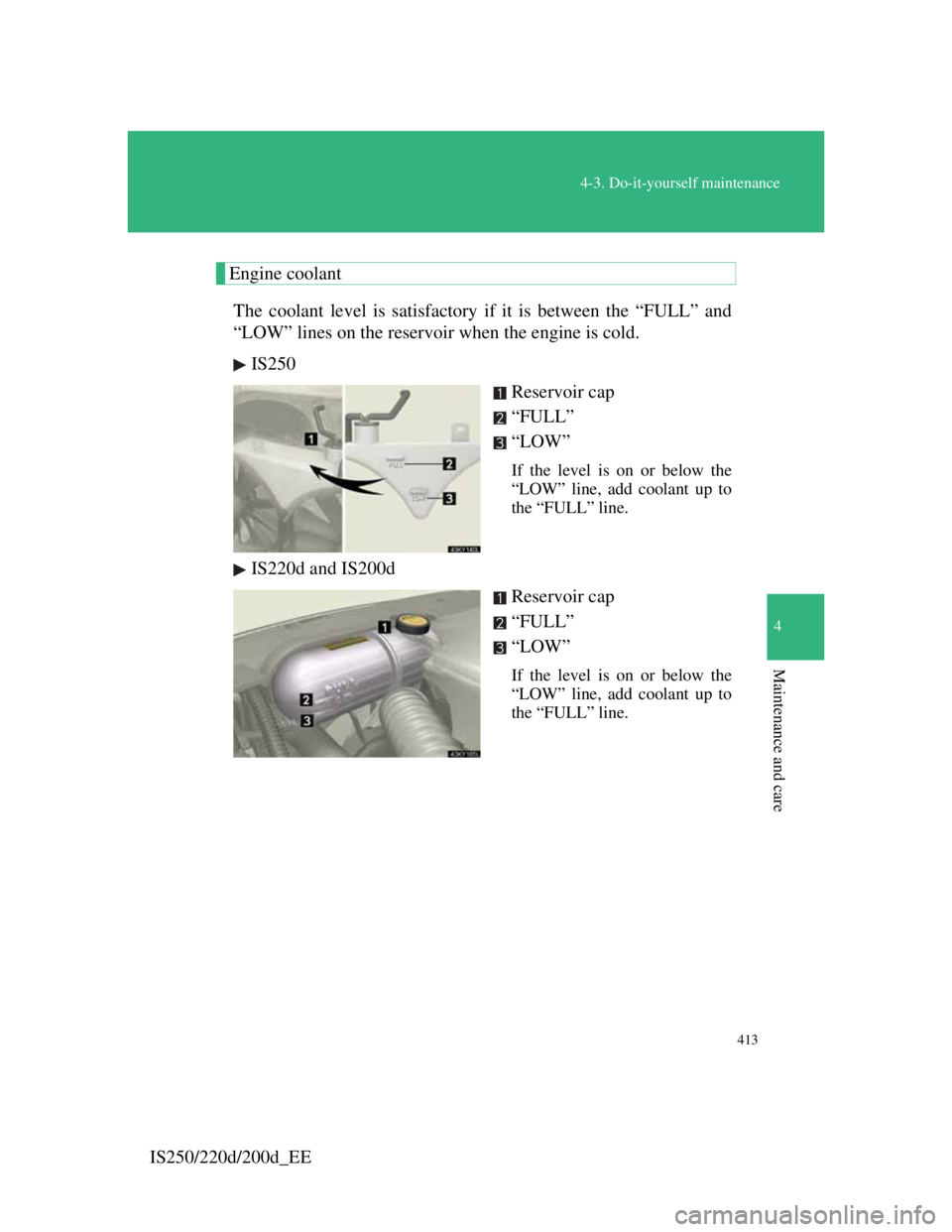
413
4-3. Do-it-yourself maintenance
4
Maintenance and care
IS250/220d/200d_EE
Engine coolant
The coolant level is satisfactory if it is between the “FULL” and
“LOW” lines on the reservoir when the engine is cold.
IS250
Reservoir cap
“FULL”
“LOW”
If the level is on or below the
“LOW” line, add coolant up to
the “FULL” line.
IS220d and IS200d
Reservoir cap
“FULL”
“LOW”
If the level is on or below the
“LOW” line, add coolant up to
the “FULL” line.
Page 435 of 609
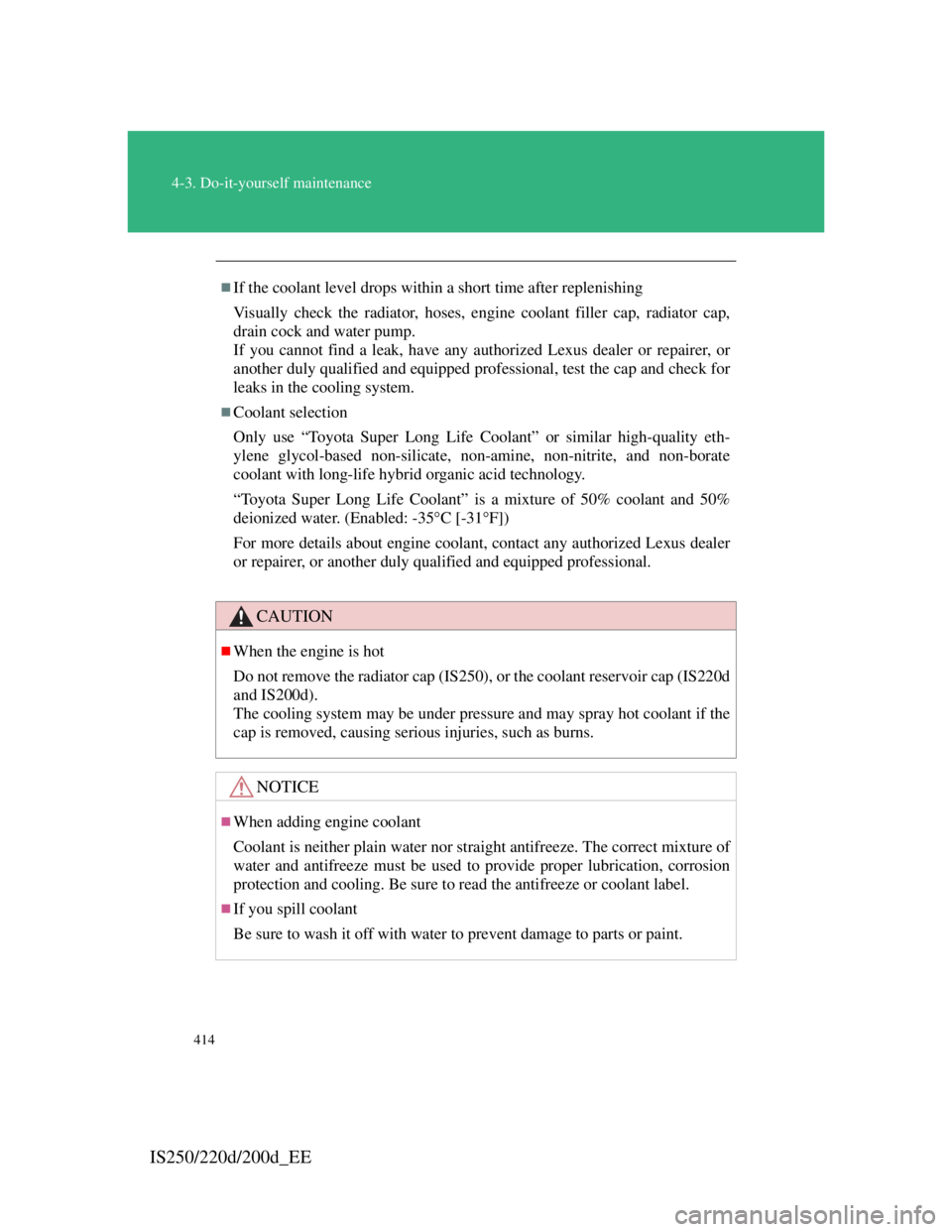
414
4-3. Do-it-yourself maintenance
IS250/220d/200d_EE
If the coolant level drops within a short time after replenishing
Visually check the radiator, hoses, engine coolant filler cap, radiator cap,
drain cock and water pump.
If you cannot find a leak, have any authorized Lexus dealer or repairer, or
another duly qualified and equipped professional, test the cap and check for
leaks in the cooling system.
Coolant selection
Only use “Toyota Super Long Life Coolant” or similar high-quality eth-
ylene glycol-based non-silicate, non-amine, non-nitrite, and non-borate
coolant with long-life hybrid organic acid technology.
“Toyota Super Long Life Coolant” is a mixture of 50% coolant and 50%
deionized water. (Enabled: -35C [-31F])
For more details about engine coolant, contact any authorized Lexus dealer
or repairer, or another duly qualified and equipped professional.
CAUTION
When the engine is hot
Do not remove the radiator cap (IS250), or the coolant reservoir cap (IS220d
and IS200d).
The cooling system may be under pressure and may spray hot coolant if the
cap is removed, causing serious injuries, such as burns.
NOTICE
When adding engine coolant
Coolant is neither plain water nor straight antifreeze. The correct mixture of
water and antifreeze must be used to provide proper lubrication, corrosion
protection and cooling. Be sure to read the antifreeze or coolant label.
If you spill coolant
Be sure to wash it off with water to prevent damage to parts or paint.
Page 436 of 609
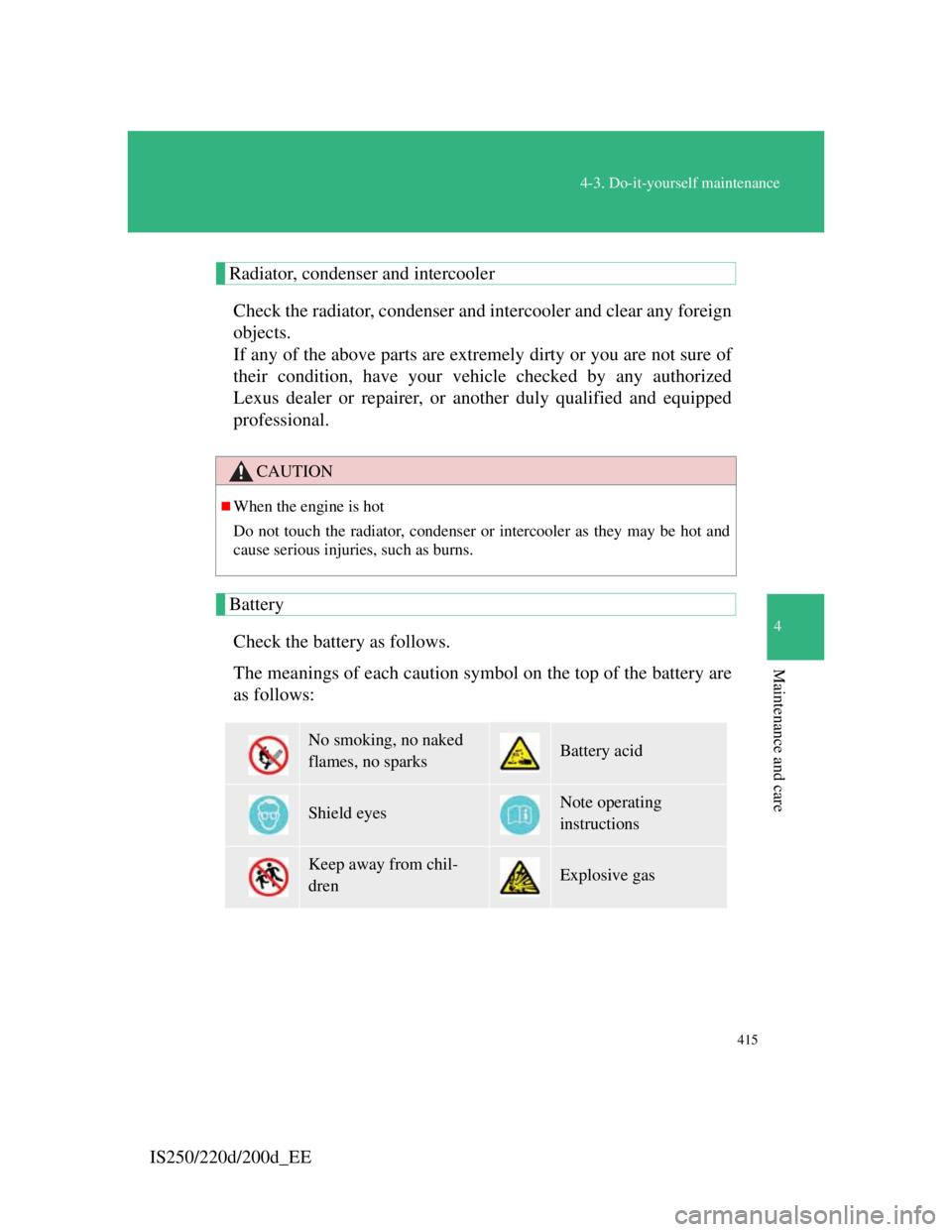
415
4-3. Do-it-yourself maintenance
4
Maintenance and care
IS250/220d/200d_EE
Radiator, condenser and intercooler
Check the radiator, condenser and intercooler and clear any foreign
objects.
If any of the above parts are extremely dirty or you are not sure of
their condition, have your vehicle checked by any authorized
Lexus dealer or repairer, or another duly qualified and equipped
professional.
Battery
Check the battery as follows.
The meanings of each caution symbol on the top of the battery are
as follows:
CAUTION
When the engine is hot
Do not touch the radiator, condenser or intercooler as they may be hot and
cause serious injuries, such as burns.
No smoking, no naked
flames, no sparksBattery acid
Shield eyesNote operating
instructions
Keep away from chil-
drenExplosive gas
Page 437 of 609

416
4-3. Do-it-yourself maintenance
IS250/220d/200d_EEBattery exterior
Make sure that the battery terminals are not corroded and that
there are no loose connections, cracks, or loose clamps.
Te r m i n a l s
Hold-down clamp
Checking battery fluid
Check that the level is between
“UPPER LEVEL” and
“LOWER LEVEL”.
“UPPER LEVEL”
“LOWER LEVEL”
If the fluid level is at or below
“LOWER LEVEL”, add dis-
tilled water.
Page 438 of 609

417
4-3. Do-it-yourself maintenance
4
Maintenance and care
IS250/220d/200d_EEAdding distilled water
Remove the vent plug.
Add distilled water.
If the “UPPER LEVEL” line cannot be seen, check the fluid level
by looking directly at the cell.
Put the vent plug back on and close securely.
Lo O.K
STEP1
STEP2
STEP3
Page 439 of 609
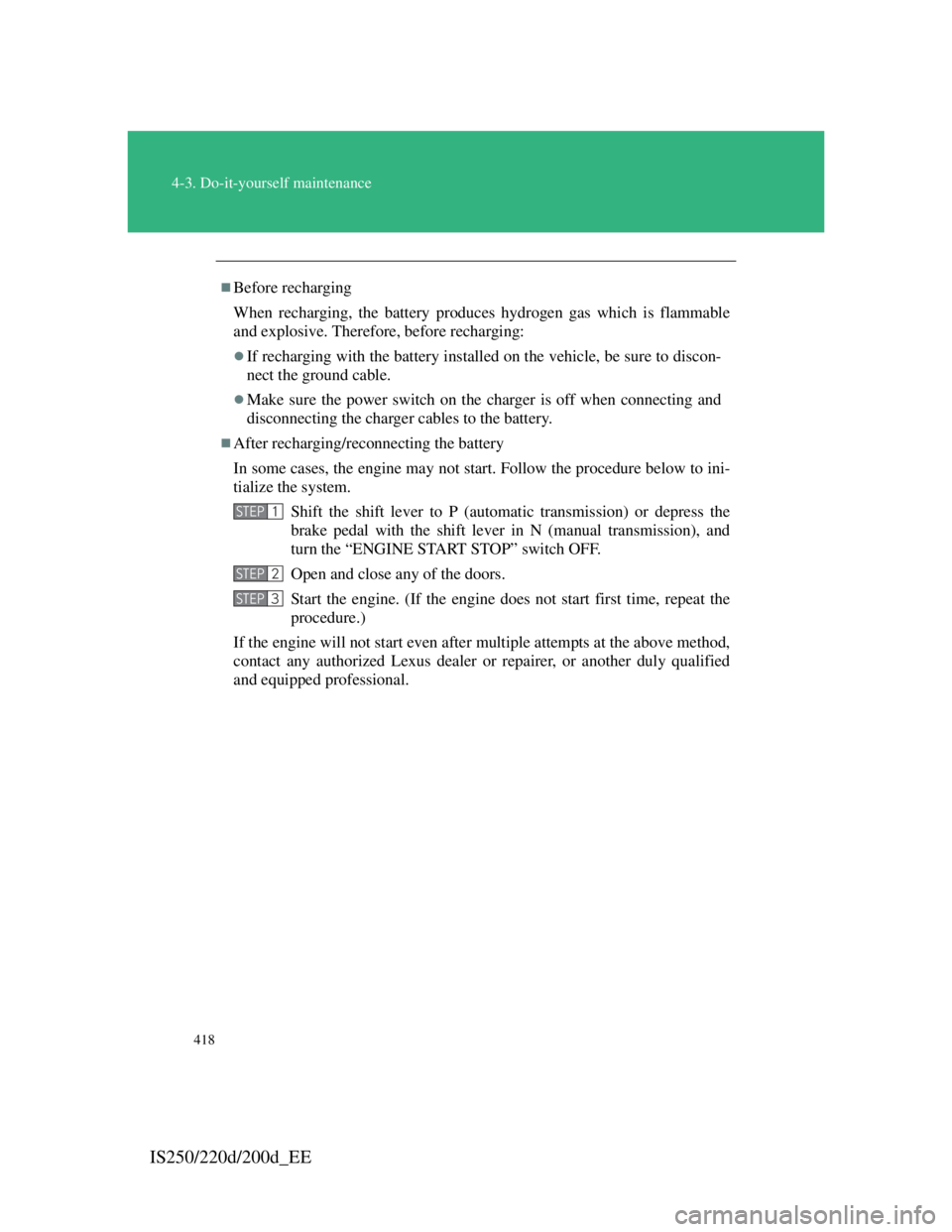
418
4-3. Do-it-yourself maintenance
IS250/220d/200d_EE
Before recharging
When recharging, the battery produces hydrogen gas which is flammable
and explosive. Therefore, before recharging:
If recharging with the battery installed on the vehicle, be sure to discon-
nect the ground cable.
Make sure the power switch on the charger is off when connecting and
disconnecting the charger cables to the battery.
After recharging/reconnecting the battery
In some cases, the engine may not start. Follow the procedure below to ini-
tialize the system.
Shift the shift lever to P (automatic transmission) or depress the
brake pedal with the shift lever in N (manual transmission), and
turn the “ENGINE START STOP” switch OFF.
Open and close any of the doors.
Start the engine. (If the engine does not start first time, repeat the
procedure.)
If the engine will not start even after multiple attempts at the above method,
contact any authorized Lexus dealer or repairer, or another duly qualified
and equipped professional.
STEP1
STEP2
STEP3
Page 440 of 609

419
4-3. Do-it-yourself maintenance
4
Maintenance and care
IS250/220d/200d_EE
CAUTION
Chemicals in the battery
A battery contains poisonous and corrosive sulfuric acid and may produce
hydrogen gas which is flammable and explosive. To reduce the risk of death
or serious injury, take the following precautions while working on or near
the battery:
Do not cause sparks by touching the battery terminals with tools.
Do not smoke or light a match near the battery.
Avoid contact with eyes, skin and clothes.
Never inhale or swallow electrolyte.
Wear protective safety glasses when working near the battery.
Keep children away from the battery.
Where to safely charge the battery
Always charge the battery in an open area. Do not charge the battery in a
garage or closed room where there is not sufficient ventilation.
Emergency measures regarding electrolyte
If electrolyte gets in your eyes
Flush your eyes with clean water for at least 15 minutes and get immedi-
ate medical attention. If possible, continue to apply water with a sponge or
cloth while traveling to the nearest medical facility.
If electrolyte gets on your skin
Wash the affected area thoroughly. If you feel pain or burning, get medical
attention immediately.
If electrolyte gets on your clothes
It can soak through clothing on to your skin. Immediately take off the
clothing and follow the procedure above if necessary.
If you accidentally swallow electrolyte
Drink a large quantity of water or milk. Get emergency medical attention
immediately.